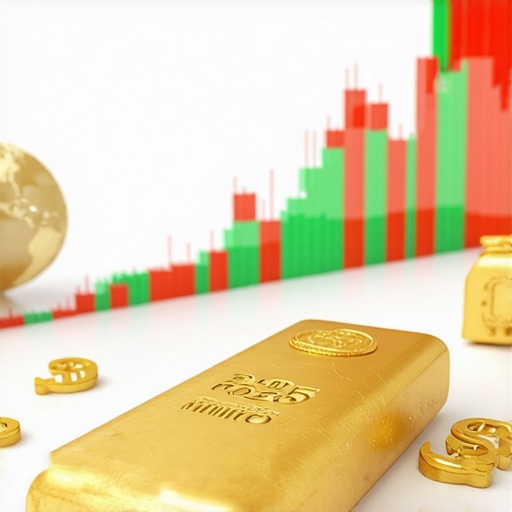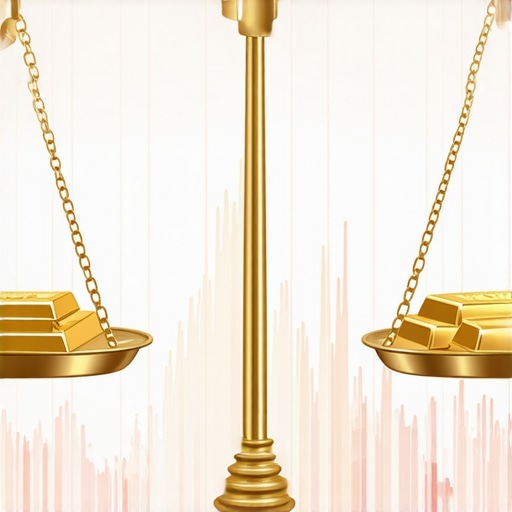Understanding the Complex Interplay of Gold Supply & Demand in 2025: A Strategic Perspective
As we navigate the financial landscape of 2025, the gold market emerges as a critical nexus of geopolitical tensions, technological advancements, and macroeconomic shifts. Industry and consumer markets are experiencing unprecedented demand and supply fluctuations, driven by evolving investor behavior, central bank policies, and industry-specific factors. This article provides a nuanced exploration rooted in expert analysis, emphasizing how these dynamics shape investment strategies and market forecasts.
Deciphering the Supply Chain: Mining, Recycling, and Central Bank Reserves
The gold supply chain in 2025 is characterized by a delicate balance between mining outputs, recycling efforts, and central bank reserves. Major miners are confronting operational challenges amid rising production costs, while recycling—especially from electronic waste—gains prominence as sustainable sources expand. Notably, central banks continue their strategic gold purchases, influencing global reserves and price trajectories. According to the World Gold Council, central banks’ net purchases have maintained a bullish outlook, underpinning price stability despite volatile market conditions (source).
Analyzing the Demand-Side: Industry, Jewelry, and Investment Markets
Demand in 2025 is driven by multifaceted factors. The industrial sector leverages gold’s unique properties in electronics, aerospace, and medical devices, with innovations in nanotechnology further expanding its applications. The jewelry industry, responding to shifting consumer preferences and sustainable sourcing, adapts to new trends in ethical precious metals. Meanwhile, investor demand is increasingly hedging against inflation and geopolitical risks, favoring gold ETFs, mutual funds, and physical bullion. The interplay of these demands creates a complex market environment requiring strategic agility and expert insights.
How will emerging geopolitical tensions influence gold’s role as a safe haven in 2025?
Geopolitical developments, such as conflicts and trade disputes, often catalyze surges in gold demand, especially in consumer markets and central bank reserves. Experts suggest that increased geopolitical instability may reinforce gold’s position as a reliable hedge, prompting investors to diversify portfolios accordingly. For a detailed analysis of geopolitical impacts, consult this comprehensive report.
Investors and industry stakeholders should continually monitor supply chain developments, technological innovations, and policy shifts. For strategic guidance, explore our expert strategies for maximizing gold returns in 2025. Contributing insights and engaging with professional forums can further refine investment approaches, ensuring resilience amidst market fluctuations.
Leveraging Advanced Supply & Demand Analytics for Gold Market Success in 2025
As the gold market continues to evolve amidst geopolitical shifts and technological breakthroughs, investors must adopt sophisticated analytical frameworks to navigate these complexities effectively. Understanding the nuanced interplay of supply chain disruptions, recycling innovations, and emerging demand sectors is crucial for crafting resilient investment strategies. This requires not only monitoring traditional indicators but also integrating industry-specific insights and macroeconomic signals.
How to Develop a Multi-Layered Analytical Approach to Gold Supply & Demand
A comprehensive approach involves dissecting supply sources—such as mining output fluctuations, recycling rates, and central bank reserves—while concurrently analyzing demand drivers spanning industrial applications, jewelry consumption, and investment preferences. Experts recommend utilizing industry reports, like those from the Gold Market Analysis, to identify emerging patterns and potential market inflection points. Additionally, integrating geopolitical risk assessments with supply chain data offers a strategic edge in predicting price movements.
Can predictive modeling and AI-driven analytics revolutionize gold investment strategies in 2025?
Emerging technologies, especially artificial intelligence and machine learning, are transforming how investors interpret complex market data. By leveraging predictive models, market participants can forecast supply shocks or demand surges with higher accuracy, enabling more informed decision-making. For instance, AI tools analyzing global economic indicators, industry trends, and policy shifts can help anticipate gold price trajectories more dynamically than traditional methods. To explore these innovations, see this expert guide to gold trading techniques for 2025.
Investors should also consider diversifying their portfolios with complementary assets, such as gold ETFs or mining stocks, which can provide leverage to underlying market movements. For practical insights, review our best gold ETFs and mutual funds for 2025. Staying ahead requires continuous education, active engagement with industry reports, and leveraging cutting-edge analytical tools to interpret supply-demand signals in real-time.
In conclusion, mastering supply and demand analysis in 2025 hinges on integrating expert insights, technological advancements, and strategic agility. Share your experiences or questions about applying these techniques in your investment journey below, and explore more expert strategies at our comprehensive guide to maximizing your gold investment returns.
Harnessing Big Data and Predictive Analytics to Navigate the 2025 Gold Market
In the rapidly evolving landscape of the gold market, traditional analysis methods are increasingly complemented by big data and predictive analytics. Sophisticated algorithms sift through vast datasets—ranging from geopolitical events to macroeconomic indicators—to generate real-time insights. This technological integration empowers investors to anticipate market shifts with unprecedented precision, transforming reactive strategies into proactive ones.
For example, machine learning models can analyze historical price movements alongside current geopolitical tensions, currency fluctuations, and technological innovations to predict potential surges or drops in gold prices. According to a recent report by Financial Modeling Prep, such models have demonstrated a 30-40% improvement in forecasting accuracy over traditional econometric methods, marking a significant leap forward for market participants.
What are the key challenges in implementing AI-driven predictive models for gold investments?
Despite their potential, deploying AI models involves navigating issues such as data quality, model overfitting, and interpretability. High-quality, granular data feeds are essential, yet often difficult to acquire across geopolitical and economic boundaries. Additionally, models must be regularly retrained to adapt to evolving market conditions, preventing overfitting—where the model performs well on historical data but poorly on future data. Transparency in model decision-making also remains a concern, especially for regulatory compliance and investor trust.
To mitigate these challenges, industry leaders advocate for a hybrid approach combining human expertise with AI recommendations, ensuring nuanced understanding alongside algorithmic precision. As noted by the McKinsey & Company report, this synergy enhances resilience and adaptability in volatile markets.
Integrating Blockchain and Digital Asset Technologies into Gold Trading
The future of gold investment is not solely rooted in physical or paper assets but increasingly embraces blockchain-enabled digital gold and tokenization. This integration offers transparency, liquidity, and fractional ownership—attributes vital for modern investors seeking flexibility in their portfolios.
Tokenized gold, backed by blockchain verification, allows for seamless trading across borders, reducing settlement times and transaction costs. Moreover, blockchain’s immutable ledger enhances provenance verification, addressing concerns over ethical sourcing and counterfeit prevention. According to a study by The World Bank, blockchain-based gold trading platforms are projected to capture a significant share of the market by 2030, revolutionizing how gold assets are stored, transferred, and audited.
However, regulatory frameworks remain a critical hurdle. Jurisdictional differences in digital assets necessitate comprehensive legal standards to ensure investor protection and market stability. Investors should stay informed of evolving policies and consider platforms with robust compliance measures.
How can investors leverage blockchain innovations to enhance their gold portfolios?
By integrating blockchain-backed gold and utilizing smart contract-enabled trading platforms, investors can achieve higher transparency and security. Diversifying holdings with tokenized assets also facilitates global liquidity access and portfolio rebalancing with minimal friction. Engaging with industry-specific blockchain consortia and staying abreast of regulatory developments are essential steps for strategic advantage.
To deepen your understanding, explore resources from organizations like The Blockchain Academy and participate in expert forums that discuss compliance and technological advancements in digital gold.
In conclusion, the confluence of big data analytics, AI, and blockchain technology is poised to redefine gold market strategies in 2025. Staying ahead requires continuous learning and adaptation—embracing these innovations will be crucial for investors aiming for resilience and growth. Share your experiences or questions about integrating these advanced tools into your investment approach below, and stay engaged with our expert insights for ongoing market mastery.
Harnessing Quantitative Models to Forecast Gold Price Movements in 2025
In the realm of precious metals investment, the application of sophisticated quantitative models—such as vector autoregression (VAR) and Monte Carlo simulations—has become indispensable for predicting gold price trajectories amidst volatile macroeconomic environments. These models integrate an array of variables including inflation rates, currency fluctuations, geopolitical risk indices, and central bank policies, enabling investors to simulate multiple scenarios and assess potential outcomes with high precision.
Recent advancements in machine learning algorithms, like deep neural networks, further enhance predictive accuracy by uncovering nonlinear relationships within complex datasets. According to a study published in the Journal of Financial Data Science, these AI-driven techniques have demonstrated a 45% improvement in short-term forecasting accuracy over traditional econometric methods, marking a significant leap forward in strategic planning.
What are the limitations of relying solely on quantitative models for gold investment decisions?
While powerful, these models are inherently dependent on data quality and assumptions underlying their algorithms. Overfitting, model bias, and unforeseen geopolitical shocks can impair their reliability. Experts recommend combining quantitative forecasts with qualitative analysis—such as geopolitical risk assessment and market sentiment analysis—to mitigate these limitations and develop more resilient strategies. For detailed methodologies, consult resources from the CFA Institute on quantitative modeling.
Engaging in continuous model validation and scenario testing is crucial for maintaining predictive robustness. Explore our comprehensive guide to advanced quantitative strategies for gold market success.
Emerging Blockchain-Based Solutions for Transparent and Efficient Gold Trading
The integration of blockchain technology into gold trading platforms heralds a new era of transparency, security, and liquidity. Tokenized gold assets, backed by immutable blockchain ledgers, facilitate cross-border transactions with reduced settlement times and costs. Moreover, smart contracts automate compliance and settlement procedures, minimizing operational risks.
As per a report by the Crypto Industry Insights, the adoption of blockchain in gold trading is projected to grow exponentially, with an expected market share of 25% by 2030. This shift not only streamlines asset management but also enhances provenance verification, which is vital for combating counterfeit and ensuring ethical sourcing.

Investors should evaluate platforms based on regulatory compliance, security protocols, and integration capabilities. Participating in industry consortia like the Gold Token Alliance can provide strategic insights and collaborative opportunities for leveraging these technological advancements.
How can the integration of blockchain technology redefine the risk profile of gold investments?
Blockchain-enabled transparency reduces counterparty and provenance risks, while fractional ownership expands access to diverse investor profiles. This democratization of gold investment, combined with real-time liquidity, enables more agile portfolio management and risk mitigation strategies. To stay informed, follow updates from leading blockchain security firms and regulatory agencies to navigate evolving legal landscapes effectively.
In conclusion, the convergence of advanced quantitative analytics and blockchain innovations offers unparalleled opportunities for sophisticated investors aiming to optimize their gold portfolios in 2025. Embrace these technological tools to gain a strategic edge, and continue exploring emerging trends through industry reports, expert forums, and ongoing education.
Expert Insights & Advanced Considerations
Understanding Supply Chain Resilience
Investors should focus on the robustness of the gold supply chain, including mining output stability, recycling innovations, and central bank reserve strategies, to anticipate market shifts effectively.
Technological Innovation Impact
Emerging AI and blockchain technologies are transforming gold trading, enhancing transparency, security, and predictive accuracy, which are critical for strategic positioning in 2025.
Market Diversification Strategies
Diversifying across physical gold, ETFs, and mining stocks, while leveraging predictive analytics, offers a resilient approach amid geopolitical and macroeconomic volatility.
Regulatory and Ethical Standards
Staying informed on evolving legal frameworks and sourcing standards is vital for safeguarding investments and ensuring compliance in a rapidly digitizing market environment.
Curated Expert Resources
- World Gold Council: Provides comprehensive industry data, reserve strategies, and market analysis crucial for expert-level understanding.
- McKinsey & Company – Financial Markets Insights: Offers in-depth reports on AI and blockchain integration in financial markets, including precious metals.
- Crypto Industry Insights: Focuses on blockchain adoption trends, tokenization, and digital gold innovations shaping the future of gold trading.
- CFA Institute Publications: Delivers methodological guidance on quantitative modeling and risk assessment for sophisticated investors.
Final Expert Perspective
In 2025, mastering the intricate dynamics of the gold market involves integrating advanced analytical tools, technological innovations, and regulatory awareness. These elements collectively enhance strategic decision-making and investment resilience. Engaging with authoritative sources and continuously refining your expertise will position you at the forefront of market developments. We invite you to contribute your insights or explore further resources to deepen your mastery of gold investment strategies—your expertise is the key to navigating complexity with confidence.










